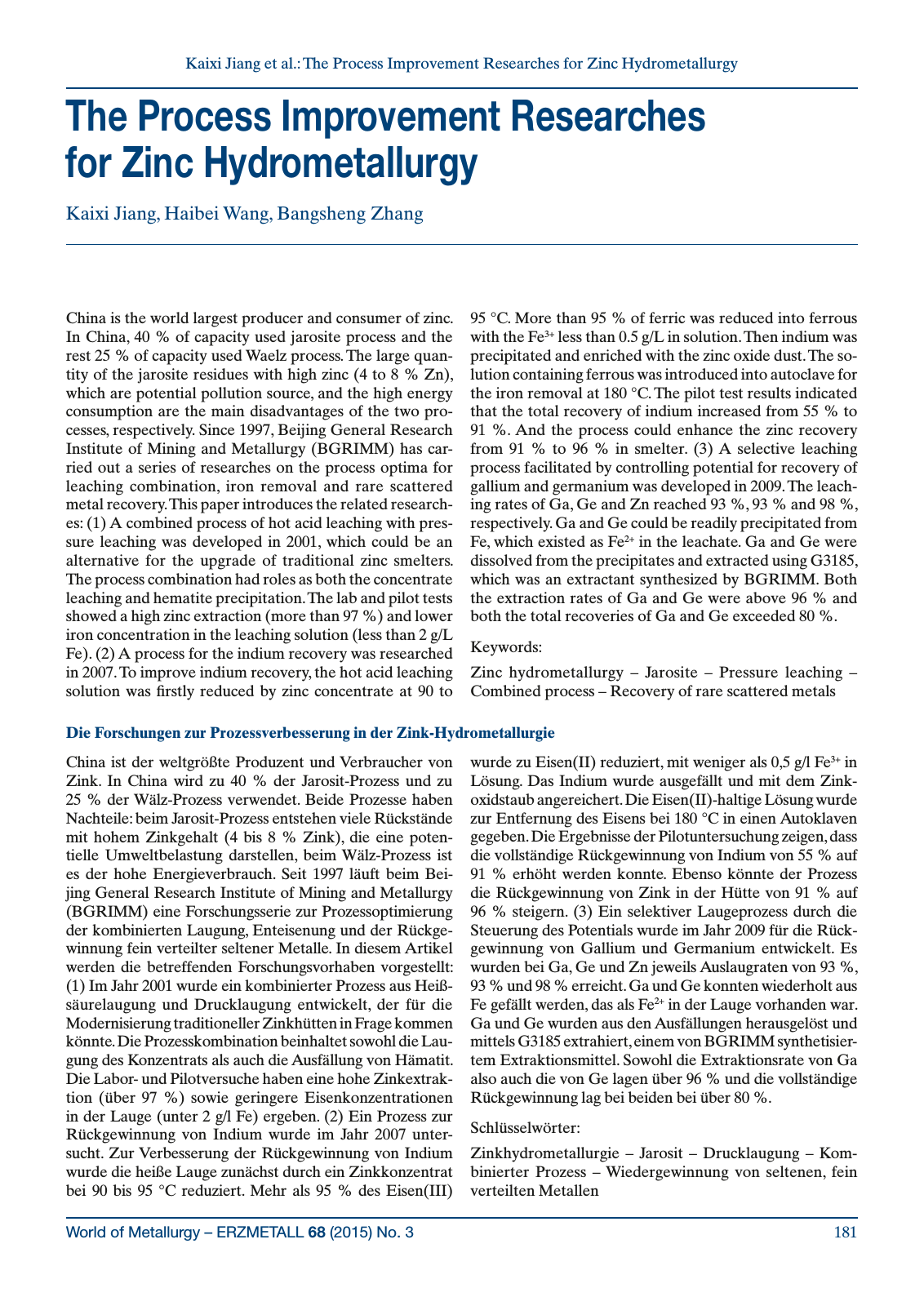World of Metallurgy ERZMETALL 68 2015 No 3 181 Kaixi Jiang et al The Process Improvement Researches for Zinc Hydrometallurgy The Process Improvement Researches for Zinc Hydrometallurgy Kaixi Jiang Haibei Wang Bangsheng Zhang China is the world largest producer and consumer of zinc In China 40 of capacity used jarosite process and the rest 25 of capacity used Waelz process The large quan tity of the jarosite residues with high zinc 4 to 8 Zn which are potential pollution source and the high energy consumption are the main disadvantages of the two pro cesses respectively Since 1997 Beijing General Research Institute of Mining and Metallurgy BGRIMM has car ried out a series of researches on the process optima for leaching combination iron removal and rare scattered metal recovery This paper introduces the related research es 1 A combined process of hot acid leaching with pres sure leaching was developed in 2001 which could be an alternative for the upgrade of traditional zinc smelters The process combination had roles as both the concentrate leaching and hematite precipitation The lab and pilot tests showed a high zinc extraction more than 97 and lower iron concentration in the leaching solution less than 2 g L Fe 2 A process for the indium recovery was researched in 2007 To improve indium recovery the hot acid leaching solution was firstly reduced by zinc concentrate at 90 to 95 C More than 95 of ferric was reduced into ferrous with the Fe3 less than 0 5 g L in solution Then indium was precipitated and enriched with the zinc oxide dust The so lution containing ferrous was introduced into autoclave for the iron removal at 180 C The pilot test results indicated that the total recovery of indium increased from 55 to 91 And the process could enhance the zinc recovery from 91 to 96 in smelter 3 A selective leaching process facilitated by controlling potential for recovery of gallium and germanium was developed in 2009 The leach ing rates of Ga Ge and Zn reached 93 93 and 98 respectively Ga and Ge could be readily precipitated from Fe which existed as Fe2 in the leachate Ga and Ge were dissolved from the precipitates and extracted using G3185 which was an extractant synthesized by BGRIMM Both the extraction rates of Ga and Ge were above 96 and both the total recoveries of Ga and Ge exceeded 80 Keywords Zinc hydrometallurgy Jarosite Pressure leaching Combined process Recovery of rare scattered metals Die Forschungen zur Prozessverbesserung in der Zink Hydrometallurgie Schlüsselwörter Zinkhydrometallurgie Jarosit Drucklaugung Kom binierter Prozess Wiedergewinnung von seltenen fein verteilten Metallen China ist der weltgrößte Produzent und Verbraucher von Zink In China wird zu 40 der Jarosit Prozess und zu 25 der Wälz Prozess verwendet Beide Prozesse haben Nachteile beim Jarosit Prozess entstehen viele Rückstände mit hohem Zinkgehalt 4 bis 8 Zink die eine poten tielle Umweltbelastung darstellen beim Wälz Prozess ist es der hohe Energieverbrauch Seit 1997 läuft beim Bei jing General Research Institute of Mining and Metallurgy BGRIMM eine Forschungsserie zur Prozessoptimierung der kombinierten Laugung Enteisenung und der Rückge winnung fein verteilter seltener Metalle In diesem Artikel werden die betreffenden Forschungsvorhaben vorgestellt 1 Im Jahr 2001 wurde ein kombinierter Prozess aus Heiß säurelaugung und Drucklaugung entwickelt der für die Modernisierung traditioneller Zinkhütten in Frage kommen könnte Die Prozesskombination beinhaltet sowohl die Lau gung des Konzentrats als auch die Ausfällung von Hämatit Die Labor und Pilotversuche haben eine hohe Zinkextrak tion über 97 sowie geringere Eisenkonzentrationen in der Lauge unter 2 g l Fe ergeben 2 Ein Prozess zur Rückgewinnung von Indium wurde im Jahr 2007 unter sucht Zur Verbesserung der Rückgewinnung von Indium wurde die heiße Lauge zunächst durch ein Zinkkonzentrat bei 90 bis 95 C reduziert Mehr als 95 des Eisen III wurde zu Eisen II reduziert mit weniger als 0 5 g l Fe3 in Lösung Das Indium wurde ausgefällt und mit dem Zink oxidstaub angereichert Die Eisen II haltige Lösung wurde zur Entfernung des Eisens bei 180 C in einen Autoklaven gegeben Die Ergebnisse der Pilotuntersuchung zeigen dass die vollständige Rückgewinnung von Indium von 55 auf 91 erhöht werden konnte Ebenso könnte der Prozess die Rückgewinnung von Zink in der Hütte von 91 auf 96 steigern 3 Ein selektiver Laugeprozess durch die Steuerung des Potentials wurde im Jahr 2009 für die Rück gewinnung von Gallium und Germanium entwickelt Es wurden bei Ga Ge und Zn jeweils Auslaugraten von 93 93 und 98 erreicht Ga und Ge konnten wiederholt aus Fe gefällt werden das als Fe2 in der Lauge vorhanden war Ga und Ge wurden aus den Ausfällungen herausgelöst und mittels G3185 extrahiert einem von BGRIMM synthetisier tem Extraktionsmittel Sowohl die Extraktionsrate von Ga also auch die von Ge lagen über 96 und die vollständige Rückgewinnung lag bei beiden bei über 80

Hinweis: Dies ist eine maschinenlesbare No-Flash Ansicht.
Klicken Sie hier um zur Online-Version zu gelangen.
Klicken Sie hier um zur Online-Version zu gelangen.